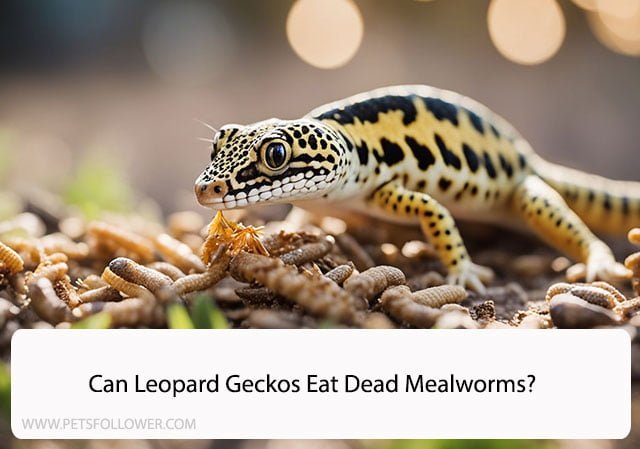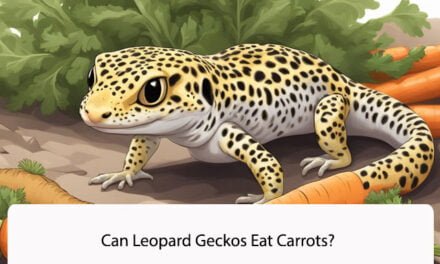Leopard geckos are one of the most popular reptile pets, and for good reason. They are easy to care for, have unique personalities, and are generally healthy. However, one of the most common questions that new leopard gecko owners ask is whether or not their pets can eat dead mealworms.

The answer is yes, leopard geckos can eat dead mealworms. In fact, many breeders and experienced owners prefer to feed their geckos pre-killed insects, as it eliminates the risk of the insects injuring or biting the gecko. Dead mealworms are also easier to handle and store than live ones, making them a convenient option for many owners.
It is important to note, however, that while dead mealworms are safe for leopard geckos to eat, they should still be fresh and not spoiled. Spoiled insects can harbor harmful bacteria and parasites that can make your gecko sick. Additionally, it is important to provide a varied diet for your gecko to ensure that they are getting all of the nutrients they need to stay healthy.
Nutritional Needs of Leopard Geckos

As responsible pet owners, we must ensure that our leopard geckos receive a balanced and nutritious diet to maintain their health and well-being. Leopard geckos are insectivores, which means their diet consists mainly of insects. It is essential to provide them with a variety of insects to ensure they receive all the necessary nutrients.
Leopard geckos require a diet high in protein and low in fat. They also need calcium and vitamin D3 to maintain healthy bones and prevent metabolic bone disease. It is crucial to dust their food with a calcium supplement before feeding them to ensure they receive enough calcium.
Mealworms are a common food source for leopard geckos. While live mealworms are the best option, dead mealworms can also be fed to leopard geckos. However, it is essential to ensure that the dead mealworms are fresh and have not been sitting for too long. Dead mealworms that have been sitting for too long can harbor harmful bacteria and parasites, which can be harmful to your leopard gecko.
In conclusion, leopard geckos require a balanced and nutritious diet to maintain their health and well-being. Ensure that they receive a variety of insects and dust their food with a calcium supplement before feeding them. While dead mealworms can be fed to leopard geckos, it is crucial to ensure they are fresh and have not been sitting for too long.
Understanding Mealworms as a Food Source

When it comes to feeding leopard geckos, mealworms are a popular choice. However, there is some debate about whether live or dead mealworms are the best option. In this section, we will explore the benefits of live mealworms and the risks of feeding dead mealworms.
Benefits of Live Mealworms
Live mealworms are a great source of nutrition for leopard geckos. They are high in protein and fat, which are essential for growth and energy. Additionally, live mealworms provide a stimulating and interactive feeding experience for your gecko. This can help to prevent boredom and promote natural hunting behaviors.
Risks of Feeding Dead Mealworms
While dead mealworms may seem like a convenient option, there are some risks associated with feeding them to your leopard gecko. Dead mealworms are more likely to be contaminated with bacteria or fungi, which can cause illness or infection in your gecko. Additionally, dead mealworms do not provide the same level of stimulation and interaction as live mealworms.
In summary, while dead mealworms may be a convenient option, live mealworms are generally considered to be the better choice for feeding leopard geckos. They provide essential nutrition and a stimulating feeding experience, while minimizing the risks of illness or infection.
Safe Feeding Practices for Leopard Geckos

When it comes to feeding leopard geckos, it is important to follow safe feeding practices to ensure their health and well-being. Here are some guidelines to follow when feeding your leopard gecko dead mealworms:
Preparing Mealworms for Consumption
Before feeding your leopard gecko dead mealworms, it is important to properly prepare them. This involves dusting the mealworms with calcium and vitamin D3 powder to ensure your gecko is getting the necessary nutrients.
To prepare the mealworms, place them in a plastic bag with the calcium and vitamin D3 powder and shake the bag until the mealworms are coated. Alternatively, you can use a feeding dish and sprinkle the powder over the mealworms.
Determining Mealworm Freshness
It is important to only feed your leopard gecko fresh mealworms. Dead mealworms can harbor harmful bacteria and parasites that can make your gecko sick. To determine if the mealworms are fresh, look for the following signs:
- The mealworms should be plump and firm, not shriveled or soft.
- They should be moving around in the container, not lying still.
- There should be no foul odor coming from the container.
If you notice any of these signs, it is best to discard the mealworms and get a fresh batch.
By following these safe feeding practices, you can ensure that your leopard gecko is getting the necessary nutrients and staying healthy.
Health Implications of Feeding Dead Mealworms
When it comes to feeding leopard geckos, it is important to ensure that they are getting the proper nutrition they need to stay healthy. While live mealworms are a common staple in their diet, some owners may wonder if dead mealworms are a suitable alternative. In this section, we will discuss the health implications of feeding dead mealworms to leopard geckos.
Digestive Health Concerns
One concern with feeding dead mealworms is the potential impact on a leopard gecko’s digestive health. Dead mealworms can quickly become contaminated with bacteria, which can lead to digestive issues such as diarrhea and vomiting. Additionally, dead mealworms may not be as easily digestible as live ones, which can lead to impaction and other digestive blockages.
Potential for Nutrient Deficiency
Another concern with feeding dead mealworms is the potential for nutrient deficiency. Live mealworms are a good source of protein, calcium, and other essential nutrients that leopard geckos need to stay healthy. However, when mealworms die, they begin to break down and lose some of their nutritional value. This means that feeding dead mealworms exclusively could result in nutrient deficiencies, which can lead to a range of health problems.
To ensure that your leopard gecko is getting the proper nutrition they need, it is recommended to feed them live mealworms whenever possible. If you must feed them dead mealworms, be sure to do so sparingly and always ensure that they are fresh and free of contaminants. Additionally, it is important to provide a balanced diet that includes a variety of other food sources, such as crickets, waxworms, and vegetables.
Alternatives to Dead Mealworms
If you’re looking for alternative food options for your leopard gecko, there are a few options available that can provide the necessary nutrients for your pet. Here are some options to consider:
Live Prey Options
Leopard geckos are natural hunters and enjoy chasing and catching their prey. Live insects can provide a more stimulating feeding experience for your gecko. Here are some live prey options:
- Crickets: Crickets are a popular choice for leopard geckos. They are high in protein and can be gut-loaded with nutritious foods to provide additional nutrients for your gecko.
- Dubia Roaches: Dubia roaches are another great option for leopard geckos. They are high in protein and low in fat, making them a healthy choice for your pet.
- Mealworms: While we don’t recommend feeding your leopard gecko only live mealworms, they can be a good occasional treat. Just make sure to gut-load them with nutritious foods before feeding them to your gecko.
Supplemental Foods and Vitamins
In addition to live prey, there are also several supplemental foods and vitamins that can help ensure your leopard gecko is getting all the necessary nutrients. Here are some options:
- Repashy Superfoods: Repashy Superfoods are a line of powdered food supplements that can be mixed with water to create a nutritious jelly-like substance. They come in a variety of flavors and are a convenient way to provide additional vitamins and minerals for your gecko.
- Calcium Powder: Calcium powder can be sprinkled on your gecko’s food to provide additional calcium, which is important for healthy bones and egg-laying females.
- Vitamin D3 Supplement: Vitamin D3 is important for calcium absorption and can be added to your gecko’s food or water.
Overall, while dead mealworms can be a convenient option, there are several alternatives available that can provide a more nutritious and stimulating feeding experience for your leopard gecko.
Frequently Asked Questions
What alternative food options are safe for leopard geckos besides live insects?
While live insects are the most nutritious and natural food choice for leopard geckos, there are alternative options that are safe to feed. These include canned insects, freeze-dried insects, and commercially available gecko diets. However, it is important to note that these options may not be as nutritionally complete as live insects, and should not be the sole source of a leopard gecko’s diet.
Is it safe for leopard geckos to consume dried mealworms?
Yes, dried mealworms can be safely fed to leopard geckos as a supplement to their diet. However, it is important to ensure that the mealworms are not rancid or moldy before feeding, as this can cause digestive issues.
How should mealworms be prepared for feeding leopard geckos?
Live mealworms should be gut-loaded with nutritious food and dusted with a calcium supplement before feeding to leopard geckos. Dried mealworms can be offered as a snack, but should not be the main source of a leopard gecko’s diet.
What are the potential risks of feeding leopard geckos with dead mealworms?
Dead mealworms can pose a risk of bacterial contamination if they are not stored properly or if they have been dead for too long. It is important to only feed freshly deceased mealworms and to store them in a cool, dry place to prevent bacterial growth.
Are dried crickets an appropriate food choice for leopard geckos?
Dried crickets can be fed to leopard geckos as a supplement to their diet, but should not be the main source of food. As with dried mealworms, it is important to ensure that the crickets are not rancid or moldy before feeding.
How do I encourage my leopard gecko to eat mealworms if it is reluctant?
Leopard geckos can be picky eaters, but there are several methods that can be used to encourage them to eat mealworms. These include offering the mealworms in a shallow dish, wiggling them with tweezers to simulate movement, and dusting them with a flavored calcium supplement. It is important to be patient and persistent when trying to introduce new foods to a leopard gecko’s diet.





